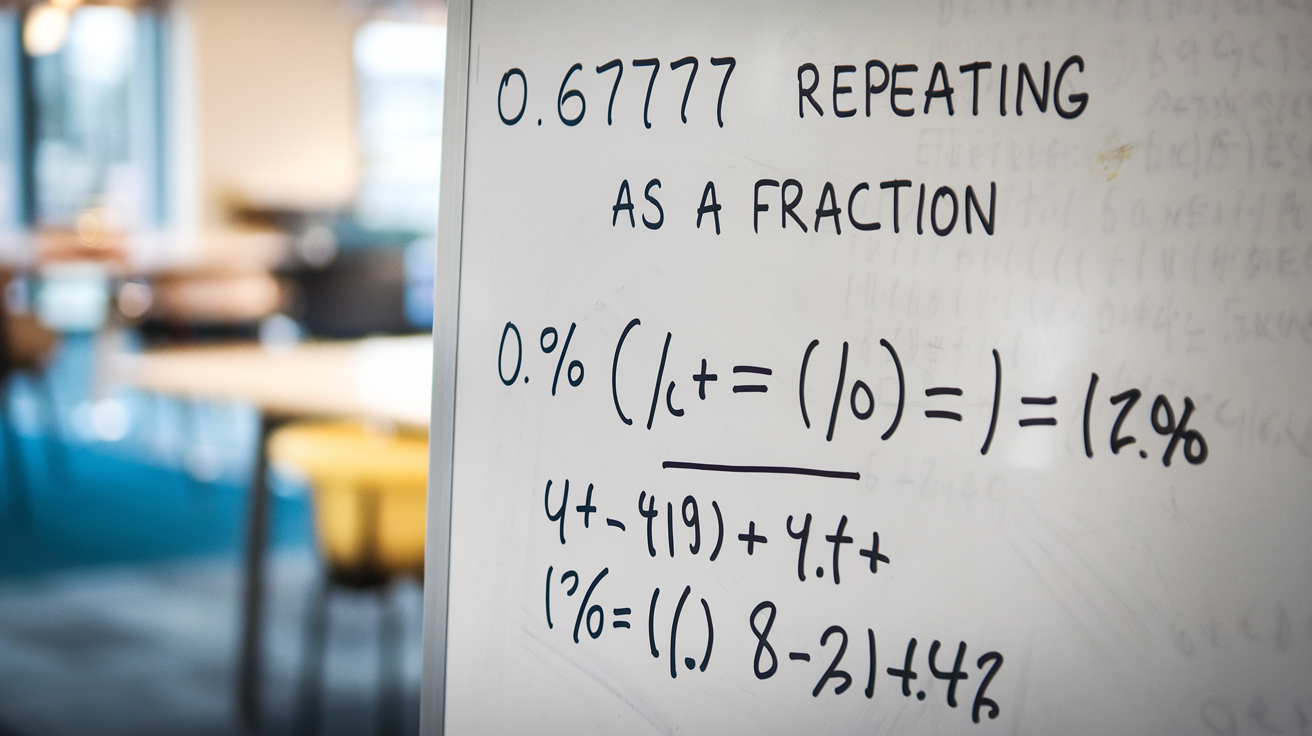
Decimals like “0.67777 repeating” often appear challenging at first glance, but understanding how to convert them into fractions can be more straightforward. Repeating decimals have a unique pattern that allows us to express them as exact fractions. In this article, we’ll focus on breaking down the decimal “0.67777 repeating as a fraction” in a clear, step-by-step manner. Using simple terms, we’ll explore what repeating decimals are, why they exist, and how to convert them.
What Is a Repeating Decimal?
Before diving into the conversion, let’s clarify what a repeating decimal is. Repeating decimals are decimals that have one or more digits that continue indefinitely. Instead of stopping, these digits repeat in a specific pattern.
In the case of 0.67777, the “7” continues to repeat forever. Mathematicians often represent this by writing it as 0.6777… with a line or dot above the repeating digit to show that it never ends.
Repeating decimals can often be expressed as fractions, which are easier to understand and work within many mathematical contexts. Converting 0.67777 repeating as a fraction will simplify understanding this number’s value in everyday calculations.
Why Convert 0.67777 Repeating as a Fraction?
Many wonder why they should convert a decimal like “0.67777 repeating” into a fraction. Here are some reasons:
- Simplicity in Calculations: Fractions are often easier to calculate because they provide an exact value.
- Clarity: Repeating decimals can look confusing, while fractions offer a more precise representation.
- Practicality: Fractions are commonly used in fields like finance, measurements, and engineering, where exact values are essential.
In this article, we’ll convert “0.67777 repeating as a fraction” to make the number more valuable and accessible.
How to Express 0.67777 Repeating as a Fraction
Let’s break down the steps to convert 0.67777 repeating into a fraction.
Define the Decimal as a Variable: We define the repeating decimal as a variable. Let’s say x = 0.67777 repeating.
Multiply by a Power of 10: Since the repeating part has only one digit (“7”), we multiply both sides of the equation by 10 to shift the decimal point to the right. This gives us:
10x=6.7777…10x = 6.7777…10x=6.7777…
Create a Second Equation: Now that we have two equations, we can subtract one. We subtract the original equation (x = 0.6777…) from the second equation (10x = 6.7777…), like this:
10x−x=6.7777…−0.6777…10x – x = 6.7777… – 0.6777…10x−x=6.7777…−0.6777…
Solve for x: The repeating decimals on the right side cancel each other out, leaving us with:
9x=6.19x = 6.19x=6.1
Now, divide both sides by 9 to solve for x:
x=6.19x = \frac{6.1}{9}x=96.1
Simplify the Fraction: To make our answer cleaner, simplify the fraction 6.19\frac{6.1}{9}96.1. Converting 6.1 to a whole number (by multiplying both the numerator and denominator by 10), we get:
x=6190x = \frac{61}{90}x=9061
This shows that 0.67777 repeating as a fraction equals 6190\frac{61}{90}9061.
Why This Method Works
The reason this approach works is based on algebraic principles. By shifting the decimal, we isolate the repeating part of the decimal, allowing us to solve for “x” as an exact fraction. Converting “0.67777 repeating as a fraction” helps us express it as a clean and clear numerical value, valid in many practical applications.
Applications of Converting Repeating Decimals to Fractions
Understanding how to convert “0.67777 repeating as a fraction” has several practical applications:
Financial Calculations: When working with money, repeating decimals can complicate matters. Using fractions can make financial calculations more transparent and reduce rounding errors.
Engineering and Design: Engineers often work with precise measurements. Fractions provide exact values, making calculations more reliable.
Daily Life: Even in everyday situations, such as cooking, construction, or budgeting, fractions can be easier to handle and more intuitive than repeating decimals.
Concluding Thoughts on 0.67777 Repeating as a Fraction
Converting “0.67777 repeating as a fraction” can transform a complex-looking decimal into a more understandable format. Repeating decimals are often confusing, but they can be simplified with the right tools and patience. Now that you understand how to convert “0.67777 repeating as a fraction,” you can apply this method to other decimals.
This process is not just about numbers—it’s about making complex ideas accessible. Following these steps lets you make sense of repeating decimals and enjoy a clearer understanding of numbers.
Common Questions about 0.67777 Repeating as a Fraction
1. What does “0.67777 repeating” mean?
“0.67777 repeating” is a decimal number where the digit “7” repeats indefinitely. In other words, after the initial “6”, the digit “7” continues forever, called a repeating decimal.
2. Why convert repeating decimals to fractions?
Converting repeating decimals to fractions provides a clear, exact representation of the number, simplifies calculations, and reduces confusion in applications requiring precision, such as engineering or financial work.
3. How do you convert “0.67777 repeating as a fraction”?
To convert “0.67777 repeating as a fraction,” we use algebraic manipulation, as this article explains. The final fraction form of 0.67777 repeating is approximately 6190\frac{61}{90}9061.
4. Is 0.67777 repeating a rational number?
Yes, “0.67777 repeating” is a rational number. Rational numbers can be expressed as fractions, and since we’ve converted it into 6190\frac{61}{90}9061, it meets the definition.
5. Are there other methods to convert repeating decimals to fractions?
Yes, other methods, such as long division, can be used, but algebraic manipulation is the most straightforward and practical approach for repeating decimals like “0.67777 repeating.”


